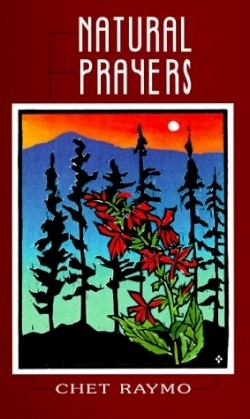Natural Prayers
Gazing at the tropical night sky from his winter retreat in the Bahamas, Raymo rhapsodizes about the Big Bang Theory and other mysteries of the universe. At his home in New England, worms, mosquitoes, songbirds and mating dragonflies capture his attention. From his summer cottage in Ireland, he meditates on the effects humans have had on the atmosphere and landscape. In his engaging and comprehensive journal of a year in the natural world from these three locations, Raymo examines subjects from microbes to constellations with the love of a naturalist and the precision of a scientist.
Some of Raymo’s material tends to be a little intimidating: protons, quarks and fountains of antimatter in the Milky Way, for example. But Raymo, a professor of physics and astronomy at Stonehill College in Massachusetts and a columnist for the Boston Globe, adeptly crosses the frontier from scientific jargon to literary prose, losing nothing discernible in the translation. But even so, many people do not care to know how much human DNA has in common with that of a worm. For the less technically-inclined, Raymo still offers plenty, such as an observation of a snapping turtle laying her eggs and a recipe for “Chinook olives” as described by early European explorers (bury a bushel of acorns near the entrance to the lodge and soak the spot with urine for four to five months before eating).
Raymo writes with a real reverence for nature, frequently invoking and quoting Thoreau’s observations of the same New England flora and fauna of a century and a half earlier. But Raymo illuminates his love with scientific understanding, going behind the scenes, or beneath the surface, to tell the reader what a biologist, physicist or astronomer sees.
Raymo recognizes that science is sometimes in conflict with those who seek to preserve nature absolutely, such as animal rights activists. He discusses his increasing discomfort about cutting open galls on plants to show his students the nests of larvae inside, a column about which prompted a letter from a reader defending the larvae. “I do not believe the matter is as simple as the reader suggests, but I know that when compassion is in immediate conflict with knowledge, we had best lean toward compassion,” Raymo writes. Although he defends the use of animals in scientific experiments, he praises the efforts of the animal rights movement in decreasing the number of animals used each year and notes that the sympathy generated for animals may help preserve biodiversity.
In rationalizing experiments such as the larvae exposure, Raymo quotes Harvard biologist E.O. Wilson quoting Senegalese conservationist Baba Dioum: “In the end, we will conserve only what we love, we will love only what we understand, we will understand only what we are taught.” Raymo writes, “The task of science today is to learn as much as possible as quickly as possible about those species that are threatened and to share that knowledge with as broad an audience as possible.”
The prevailing doctrine of Raymo’s writing is the value of science in saving the planet. He does not promote technological solutions to preserve the ozone layer or clean up the oceans; such schemes are the bane of environmentalists. But Raymo does endorse human management of the ecosystem. “The planet Earth will become increasingly humanized; nothing will reverse that trend,” Raymo writes. “Extolling wildness as the preservation of the world will get us nowhere; what is required is the political and social will to create landscapes that are works of art, spirit, praise.”
Reviewed by
Sharon Flesher
Disclosure: This article is not an endorsement, but a review. The publisher of this book provided free copies of the book to have their book reviewed by a professional reviewer. No fee was paid by the publisher for this review. Foreword Reviews only recommends books that we love. Foreword Magazine, Inc. is disclosing this in accordance with the Federal Trade Commission’s 16 CFR, Part 255.

